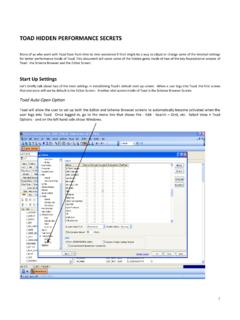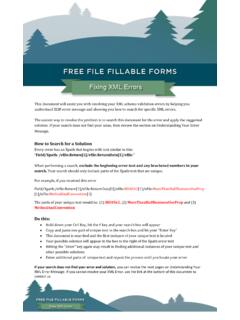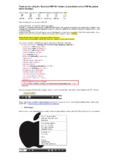Transcription of XML and Oracle: A How-To Guide for PL/SQL Users
1 Design, Develop, and Deploying your Applications Page 1 of 11 Paper # 214 XXMMLL AANNDD OORRAACCLLEE:: AA HHOOWW--TTOO GGUUIIDDEE FFOORR PPLL//SSQQLL UUSSEERRSS Eashwar Iyer, Quovera What's the best way of exchanging data between different sources without worrying about how the receiver will use it? What's the best way of creating documents with the right content without worrying how it should be displayed on the web and then able to display them with all the flexibility one could get? Welcome to the world of XML and its family of technologies. This whitepaper is aimed at understanding XML and related topics viz. XSL, DTD, DOM, SAX and Schemas. It also looks at some of the products and tools from oracle that supports XML through PL/SQL . Please note that a downloadable version of this paper and the associated presentation are available at XML AND THE RELATED TOPICS XML XML stands for eXtensible Markup Language.
2 In contrast to HTML that describes visual presentation, XML describes data in an easily readable format but without any indication of how the data is to be displayed. It is a database-neutral and device-neutral format. Since XML is truly extensible, rather than a fixed set of elements like HTML, use of XML will eventually eliminate the need for browser developers and middle-ware tools to add special HTML tags (extensions). Listing 1 is an example of a simple XML document. <?xml version=" "?> <?xml-stylesheet type="text/xsl" href=" "?> <Employees> <Empl id="1"> <FirstName> Chuck </FirstName> <LastName> White </LastName> <Dept> Finance </Dept> </Empl> </Employees> Listing 1: XSL As explained earlier, XML is more focussed on defining the data, therefore, we need a mechanism to define how this data should be displayed in browsers, cell phones or any other such devices.
3 This is exactly what XSL (eXtensible Style Language) does. It defines the rules to interpret the elements of the XML document. XSL at its most basic provides a capability similar to a "mail merge." The style sheet contains a template of the desired result structure, and identifies data in the source document to insert into this template. This model for merging data and templates is referred to as the template-driven model and works well on regular and repetitive data. Listing 2 is an example of an XSL document for the XML document shown in Listing 1. <?xml version=' '?> <xsl:stylesheet xmlns:xsl=" "> Design, Develop, and Deploying your Applications Page 2 of 11 Paper # 214 <xsl:template match="/"> <HTML> <BODY> <h1>Employee Details</h1> <xsl:for-each select="Employees/Empl"> <b>Empl # <xsl:value-of select="@id" /> </b> <i>First Name : <xsl:value-of select="FirstName" /> </i> <i>Last Name : <xsl:value-of select="LastName" /> </i> <i>Dept : <xsl:value-of select="Dept" /> </i> </xsl:for-each> </BODY> </HTML> </xsl:template> </xsl:stylesheet> Listing 2: Figure 1 shows the way the browser interprets the document when combined with the document.
4 Figure 1: Output in browser when is called. Design, Develop, and Deploying your Applications Page 3 of 11 Paper # 214 DTD DTD (Document Type Definition) is a set of rules or grammar that we define to construct our own XML rules (also called a "vocabulary"). In other words, a DTD provides the rules that define the elements and structure of our new language. This is comparable to defining table structures in oracle for a new system. As we define the columns of a table, determine the datatypes of the columns, determine if the column is 'Null' allowed or not, the DTD defines the structure for the XML document. Listing 3 is an example of a basic DTD. The detailed syntax of DTD is covered later in the paper. <Employees> <Empl> <FirstName> </FirstName> <LastName> </LastName> <Dept> </Dept> </Empl> </Employees> Listing 3: Employee DTD DOM The Document Object Model (DOM) is a simple, hierarchical naming system that makes all of the objects in the page, such as text, images, forms etc accessible to us.
5 It is merely a set of plans that allow us to reconstruct the document to a greater or lesser extent. By definition, a complete model is one that allows us to reconstruct the whole document down to the smallest detail. An incomplete DOM is anything less than that. For the reader's information, the W3 DOM recognizes seventeen types of node objects for XML: Attribute, CDATAS ection, Comment, DOMI mplementation, Data, Document, DocumentType, DocumentFragment, Element, Entity, EntityReference, NamedNodeMap, Node, NodeList, Notation, ProcessingInstruction, Text For a detailed description of other node types, the reader is encouraged to visit the W3 web site at SAX Simple API for XML (SAX) is one of the two basic APIs for manipulating XML. It is used primarily on the server side because of its characteristics of not storing the entire document in memory and processing it very fast. However, SAX should be used mainly for reading XML documents or changing simple contents.
6 Using it to do large-scale manipulations like re-ordering chapters in a book or any such activities will make it extremely complicated, not that it cannot be done. SCHEMA It s a mechanism by which rules can be defined to govern the structure and content relationship within a document. XML Schema Structures specifies the XML Schema definition language, which offers facilities for describing the structure and constraining the contents of XML documents. The schema language, which is itself represented in XML and uses namespaces, substantially reconstructs and considerably extends the capabilities, found in XML document type definitions (DTDs). This specification depends on XML Schema Part 2: Datatypes. Design, Develop, and Deploying your Applications Page 4 of 11 Paper # 214 XML Schema Datatypes is part 2 of the specification of the XML Schema language. It defines facilities for defining datatypes. The datatype language, which is itself represented in XML , provides a superset of the capabilities found in XML document type definitions (DTDs) for specifying datatypes on elements and attributes.
7 NAMESPACES With XML namespaces developers can qualify element names uniquely on the Web and thus avoid conflicts between elements with the same name. The association of a Universal Resource Identifier (URI) with a namespace is purely to ensure that two elements with the same name can remain unambiguous; no matter what the URI points to. WELL-FORMED VS. VALID XML DOCUMENTS: Well-formed documents are those that conform to basic rules of XML such as a) the document must have only one root element, b) it must have start and end tags for every element etc. Valid documents are not only well-formed but also have been validated against a DTD (or a schema). A parser usually does the validations. XML IN oracle In order to see and appreciate the implementation of XML in oracle , we need to have the necessary products and components installed. The next section briefly looks at the products that are required. A ROUND TRIP EXAMPLE WHAT DO WE WANT TO ACHIEVE?
8 To enjoy all the benefits provided by XML (and XSL, DTD etc.), the least we should be able to do are: Read data from the database and convert them into an XML document. Output the XML documents in the appropriate device (we will restrict ourselves to displaying the output in a browser). Read XML document and insert the data contained in it into the table in the database. For any real life application, the first step would be to design the database table/s and the corresponding DTD. Thereafter, an XSL document will be required for displaying the resultant XML document meaningfully. The application code to do all these manipulations will then follow. To start with, lets consider a "Zipcodes" database table with the structure as shown in Table 1: Column Name Data Type Width State_Abbreviation Character 2 ZipCode Numeric 5 Zip_Code_Extn Numeric 4 City Character 50 Table 1: Zipcodes table structure MODELING THE TABLE STRUCTURE Assuming that the table design is fine, our first step will be to create a simple DTD that mirrors its structure.
9 We've already listed the fields that make up each record in the "Zipcodes" table. There are some other rules we can state about the table: The table name is "Zipcodes". Design, Develop, and Deploying your Applications Page 5 of 11 Paper # 214 Each record in the "Zipcodes" table represents a complete mapping of zip code, the extra four digits of zip code, the city name and the state abbreviation. As a first pass at a DTD, we'll create the tags <Zipcodes>, <mappings>, etc., specifying the relationships among items we just outlined. Before we do that, we'll discuss the basics of DTD syntax. DTD BASICS Each statement in a DTD uses the <!XML DTD> syntax. This syntax begins each instruction with a left angle bracket and an exclamation mark, and ends it with a right angle bracket. DEFINING A DOCUMENT ELEMENT The document element, the outermost tag, will be the <Zipcodes> tag: <!ELEMENT Zipcodes (mappings)+> The element declaration defines the name of the tag ("Zipcodes"), and the content model for the tag ("mappings").
10 The + notation after the content model above means the <Zipcodes> tag must contain one or more <mappings> tags. There are other such notations in XML as follows: * - The content can appear 0 or any number of times. ? - The content can appear 0 or once. [none] - The content must appear once as shown. FIRST CUT DTD Listing 4 shows our first-cut DTD. The first line shows the name of the table and shows content model as described in the previous paragraph. The second line shows all the column names in a row in the table. It does not show any occurrence indicator. It means the elements must occur in the same sequence and only once. The next four lines show the columns of our table within tags. The #pcdata keyword means the tags contain 'parsed character data'. <!ELEMENT Zipcodes (mappings)+> <!ELEMENT mappings (state_abbreviation, zipcode, zip_code_extn, city)> <!ELEMENT state_abbreviation (#PCDATA)> <!ELEMENT zipcode (#PCDATA)> <!






